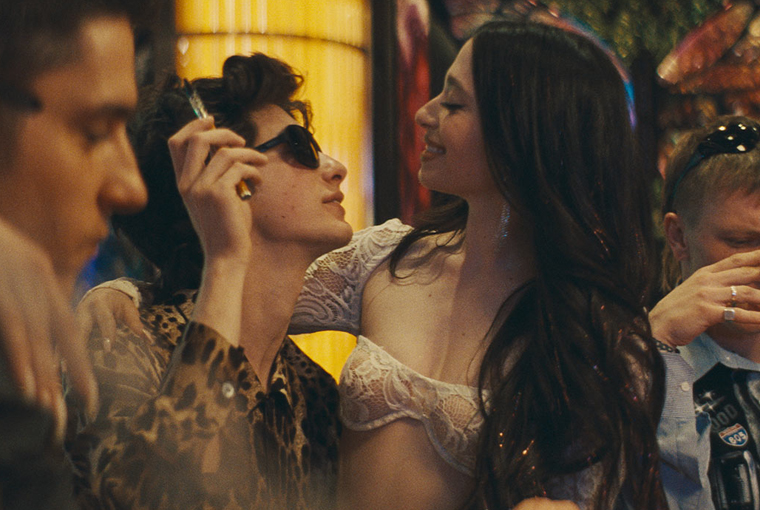The New Gaze of Moral Superiority
Sean Baker’s Anora (2024)
Vol. 149 (November 2024) by Moritz Pfeifer
In the opening chapter of Émile Zola’s Nana (1879/1880), the actress plays a role in The Blonde Venus at the Variétés, her childish clumsiness drawing laughter from the crowd. But as the performance unfolds: “All of a sudden, in the good-natured child the woman stood revealed, a disturbing woman with all the impulsive madness of her sex, opening the gates of the unknown world of desire. Nana was still smiling, but with the deadly smile of a man-eater.”1 Zola captures in a single image two archetypes that have shaped our understanding of sex workers. On one side stands the femme fatale, whose erotic power threatens to devour the patriarchal social order; on the other, the innocent girl, corrupted by circumstance but still retaining a trace of redeemable humanity. The theatricality of the scene strips away Nana’s own reality, replacing it with the one the crowd demands to see.
The courtesans of literature have almost universally been understood as projections meant for this gaze – as figures to be looked at, desired, judged, and ultimately destroyed. The femme fatale offers one version of this spectacle: women like Carmen (1845) and Esther (Splendeurs et misères des courtisanes, 1838–1847) are portrayed as dangerously autonomous, their sexual power positioned as a challenge to male authority that demands violent containment. The fallen woman offers another: women like Fantine (Les Misérables, 1862) embody victimhood, while figures like Nancy (Oliver Twist, 1837–1839) and Marguerite Gautier (La Dame aux Camélias, 1848) conform to the subtype of the “tart with a heart,” where a woman, though degraded by circumstance, preserves her moral worth through acts of loyalty and sacrifice. In each case, the sex worker is less a character with agency than a surface onto which fantasies of danger, loss, pity, and control are projected.
Cinema, perhaps even more so than literature, has exposed this gaze as gendered. The term “male gaze” itself was coined by Laura Mulvey in a 1975 essay on how classical cinema constructs women as objects to be looked at, fragmented, and possessed by male spectators. To put it mildly, then, a film about a sex worker made by a cisgender male director today risks being read for the position from which it speaks. Sean Baker’s Anora (2024) stands in this line of fire. It takes up a figure historically shaped by male fantasy at a moment when questions of authorship, authority, and appropriation are themselves under intense scrutiny.
Anora follows the story of Ani (Mikey Madison), a young stripper in Brighton Beach, Brooklyn, who meets and quickly falls into a relationship with Vanya (Mark Eydelshteyn), the sheltered son of a Russian oligarch. Their impulsive romance culminates in a spontaneous marriage, provoking the arrival of Vanya’s parents and their entourage, who attempt to dissolve the union and remove Ani from their son’s life. Over the course of a few days, Ani moves from the margins of wealth and power into its guarded center, where she is subjected to manipulation, negotiation, and humiliation. The film shifts between tones of comedy, violence, and tenderness, tracing Ani’s effort to assert herself in a world determined to define it.
Throughout Anora, Ani is carried across a catalogue of archetypes, only for the film to block each from fully taking hold. In her early scenes with Vanya, when she jokes, seduces, and commands the space around her, Ani seems to step into the role of the femme fatale. Yet, just as this image threatens to stabilize, the film undercuts it: she is revealed as a girl clinging to the fantasy of a simple, happy life. Later, when Ani stands humiliated in the hotel suite, hearing Vanya’s parents offer her money to disappear, she might have become the sentimental fallen woman, the suffering figure of pity. But the film blocks this too: Ani is neither crushed nor saintly; she swears, demands, mocks, refusing to perform pure victimhood. In scenes where she tenderly comforts Vanya or imagines their future together, Ani brushes against the “tart with a heart” image – the sex worker redeemed by love – but again the film refuses to settle there. Her loyalty is genuine, but it is also shot through with calculation, survival instinct, and self-interest.
Perhaps the clearest example of Anora’s unstable gaze occurs in the film’s final sequence, where Ani is driven home by Igor (Yura Borisov), one of Vanya’s handlers. Igor’s relationship to Ani has already passed through stages of control and objectification: he was the one tasked with restraining her, physically tying her up after Vanya’s disappearance, in a scene whose visual language is close to pornography. Ani herself comments on this later, accusing Igor of having “rape eyes.” Baker attempts to complicate this dynamic by giving Igor a moral awakening: he becomes the only character to treat Ani with something like pity, asking Vanya’s parents to apologize for their son’s betrayal. Alone together in Vanya’s apartment, Ani and Igor share a moment of wary intimacy, smoking a joint as Ani jokes that American names mean nothing – a double entente, since “Anora” actually means light and honor, but from her own experience in America, that meaning has clearly been lost. The next morning, as Igor prepares to drop Ani off, he returns her wedding ring – a gesture of unexpected kindness. Moved, Ani climbs onto his lap and initiates sex. However, when Igor attempts to kiss her, she recoils, begins to hit him, and ultimately collapses into his arms, sobbing where the film ends.
Anora assembles gestures toward each familiar gaze without ever allowing one to dominate. This transforms Ani into a patchwork of anti-clichés, which could be seen as a way of restoring personhood to a figure historically shaped by male fantasy. However, there may be an element of strategy in the instability of the gazes in this scene – shifting from domination to pity to failed intimacy. The breakdown of familiar fantasies – the fallen woman, the femme fatale – becomes a mode of representation. This assembly of broken stereotypes produces a meta-representational figure that certifies the director’s own moral awareness more than it creates a space for encountering Ani. The film’s refusal to settle may not make a fully realized subject.
It is both astonishing and not, to observe that, male critics in particular, have praised the film in exactly these terms. In a piece for the Guardian, Mark Kermode approvingly quotes Andrea Werhun, a former sex worker and creative consultant on Anora, who says that “On film, sex workers are usually depicted as victims, villains, hookers with hearts of gold or, well, dead. Sean managed to defy these tired stereotypes by paying sex workers to check his work…”2 Justin Chang writing for the New Yorker applauds Baker for making his heroine “more agent than victim,” acknowledging that “[t]here’s an uglier subgenre of crime movie that Anora acknowledges by rejection: the kind where a female sex worker winds up on a slab.”3 Danny Leigh, reviewing the film for the Financial Times, similarly praises Baker’s “pointed subversion of Pretty Woman,”4 suggesting that Anora avoids the traditional fantasy of rescue and romantic redemption. There is little in these articles about sex workers as historical subjects, or about the material realities that have shaped their representation. Instead, the focus remains on Baker’s success in evading old stereotypes, as if the primary question were not how Ani’s world is imagined, but how Baker’s handling of it reflects back on him.
Perhaps it is worth asking whether Anora, more than abolishing the male gaze, merely shifts it into a different register. The traditional economy of domination – where women were displayed for pleasure or pity – gives way to a new economy of moral exhibitionism. Ani’s life becomes valuable not for what it reveals about herself but for what it allows Baker to reveal about himself. Her function is to certify his awareness, to demonstrate what a good student he is for avoiding old traps, to serve as a credential in a culture obsessed with correct postures. This gaze is stripped of eroticism but saturated with judgment. In Anora, the woman’s body no longer carries the burden of sexual fantasy, with its implicit structures of guilt and desire; it carries the burden of male innocence, a different fantasy, organized around moral purity.
To return to Zola’s Nana, the world that surrounds her is a world in collapse: the Parisian demi-monde of courtesans, gamblers, and speculators offers a surface of brilliance over a society drifting toward political disaster. Nana’s bodily decay – Zola finishes her off with small-pox – becomes a symptom of the Second Empire’s decline, timed to the outbreak of the Franco-Prussian War. Anora stages a similar relation between personal narrative and political structure. The Russian-American demi-monde of Brighton Beach – rooted in post-Soviet wealth, criminality, and excess – sits atop unresolved political tensions, as the war in Ukraine unfolds in the background. Here, the female body is not sacrificed to punishment, but to the performance of moral superiority: Ani becomes the screen through which guilt is managed by demonstrations of virtue rather than acts of disavowal. In both cases, the woman’s body is instrumentalized to absorb the strains of a culture unable to confront its own collapse.
- Zola, É. (1972). Nana (G. Holden, Trans.). Penguin. (Original work published 1880); 44–45 ↩︎
- Kermode, M. (2025, January 4). Mark Kermode on director Sean Baker, who thrillingly puts the marginalised centre stage. The Guardian. https://www.theguardian.com/film/2025/jan/04/mark-kermode-on-director-sean-baker-who-thrillingly-puts-the-marginalised-centre-stage ↩︎
- Brody, R. (2024, October 21). Anora and the possibilities of freedom. The New Yorker. https://www.newyorker.com/magazine/2024/10/21/anora-movie-review ↩︎
- Romney, J. (2024, May 20). Anora — Sean Baker’s Cannes contender is a ribald delight. Financial Times. https://www.ft.com/content/7b8fa865-a8f8-4c93-b54b-f05947439985 ↩︎




Leave a Comment